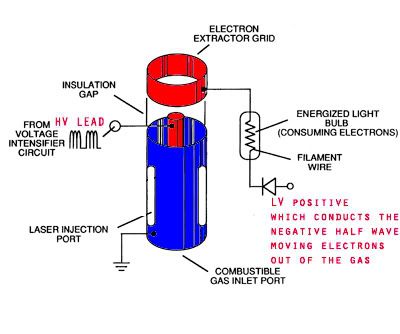diode increases speed
Hi Lee,
What is it about adding components (diodes) that shortens the impulse time?
I agree with you but what is this telling us?
First of all, low voltage cannot move through the diodes until the voltage is lower on the cathode/output side. That means that the HV side must discharge across the gap and the diodes still won't open until the voltage drops below the LV source....is that your understanding?
So it appears that if anything, the time should be extended since the HV has to happen and then drop below the LV source then the LV source discharges through diodes.
If the LV comes before the HV drops below the LV, then that defeats the entire concept of how a diode is supposed to work.
I know for a fact that the HV enters the cathode of the HV diode(s). There are easy ways for anyone to see for themselves that the HV will enter a diode.
Here is a simple test for anyone to prove that HV CAN enter the diode the wrong way and for the fact that diodes have reverse ratings should be a hint that voltage can go through the "wrong" way.
HV/plug input/plug ground/ |<---(hv diode with cathode pointing to ground) / + of capacitor / - of capacitor / negative of primary of ignition coil
Basically, there is a cap/diode in series with the ground here with diode pointing to ground of plug. When the coil fires in any normal way, the spark will spark away as if there is no diode and you will see the capacitor slowly rises with each pulse getting charged by the HV output from secondary across gap.
I'm not pointing this out to you Lee, just posting this in general because so many people have a hard time believing me when I tell them the HV enters the diode before jumping a gap. And, I think it could be relevant to the time compression you're seeing on the scope when diodes are added.
Anyway, I've already proven it to myself that the HV does go "backwards" through a diode since it will be open when the HV starts and will then shut off.
The test that I'd like to see but I don't have the equipment for is to remove the diodes and monitor the voltage at the spark plug input. Add diodes and do same. I want to see if not only does the discharge happen faster, but the voltage increases beyond what the secondary outputs...(compression against diode when diode shuts off).
With a serious increase in the voltage instantaneously...as this jumps the gap, does it literally suck the current from the LV circuit offering a negative resistance for the lv to discharge into?
I'd like to see it disproved as much as proven because this will tell a lot.
Hi Lee,
What is it about adding components (diodes) that shortens the impulse time?
I agree with you but what is this telling us?
First of all, low voltage cannot move through the diodes until the voltage is lower on the cathode/output side. That means that the HV side must discharge across the gap and the diodes still won't open until the voltage drops below the LV source....is that your understanding?
So it appears that if anything, the time should be extended since the HV has to happen and then drop below the LV source then the LV source discharges through diodes.
If the LV comes before the HV drops below the LV, then that defeats the entire concept of how a diode is supposed to work.
I know for a fact that the HV enters the cathode of the HV diode(s). There are easy ways for anyone to see for themselves that the HV will enter a diode.
Here is a simple test for anyone to prove that HV CAN enter the diode the wrong way and for the fact that diodes have reverse ratings should be a hint that voltage can go through the "wrong" way.
HV/plug input/plug ground/ |<---(hv diode with cathode pointing to ground) / + of capacitor / - of capacitor / negative of primary of ignition coil
Basically, there is a cap/diode in series with the ground here with diode pointing to ground of plug. When the coil fires in any normal way, the spark will spark away as if there is no diode and you will see the capacitor slowly rises with each pulse getting charged by the HV output from secondary across gap.
I'm not pointing this out to you Lee, just posting this in general because so many people have a hard time believing me when I tell them the HV enters the diode before jumping a gap. And, I think it could be relevant to the time compression you're seeing on the scope when diodes are added.
Anyway, I've already proven it to myself that the HV does go "backwards" through a diode since it will be open when the HV starts and will then shut off.
The test that I'd like to see but I don't have the equipment for is to remove the diodes and monitor the voltage at the spark plug input. Add diodes and do same. I want to see if not only does the discharge happen faster, but the voltage increases beyond what the secondary outputs...(compression against diode when diode shuts off).
With a serious increase in the voltage instantaneously...as this jumps the gap, does it literally suck the current from the LV circuit offering a negative resistance for the lv to discharge into?
I'd like to see it disproved as much as proven because this will tell a lot.
Originally posted by smw1998a
View Post
 ). So yes, I can confirm that your theory is most likely the correct mode of operation.
). So yes, I can confirm that your theory is most likely the correct mode of operation.








 And, GOODNIGHT zzZZZ
And, GOODNIGHT zzZZZ


Comment